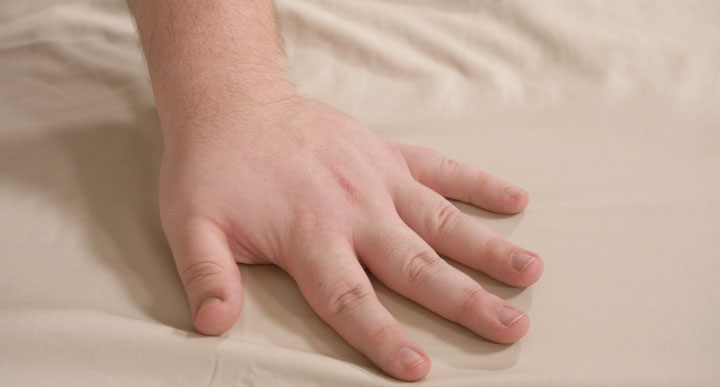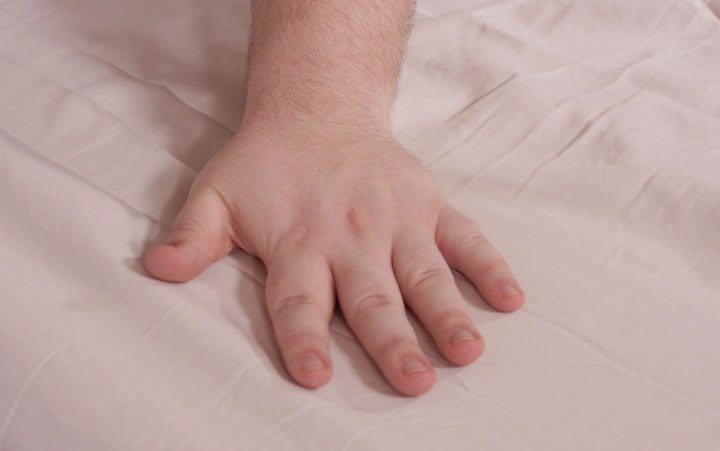Pilling sheets can be a pain. What once felt silky and smooth now has an uneven and fuzzy texture. Pilling can happen to many types of sheets, no matter the price point. But the real question is: Why are my sheets pilling and how do I get rid of it?
That’s what we’re here for! Keep reading to learn more about what causes this annoying issue and how you can make your sheets feel as good as new.
What is Pilling?
Those little balls of fuzz on your sheets have a technical term – pilling. This occurs when cotton fibers break down and get tangled. It’s usually a result of friction, which is why you often see fitted sheets pilling near the foot of the bed. Your feet could be rubbing against the material during the night, causing the fabric to break down! But that’s not the only thing that can create these pesky puff balls. Hair and stubble can rub against sheets and create a pilling problem.
Why Do Sheets Pill?
We hate to break it to you, but even some of the most expensive sheets can pill. Most of the time, pilling occurs when companies use low-quality fabrics with loose weaves. Other times, sheets pill after they’re exposed to high heat, harsh chemicals, and abrasion.
How to Fix Pilling On Your Sheets
Pilling doesn’t necessarily mean you need to rush out and purchase new sheets. There are several easy and affordable ways to refresh and revive your sheets.
Use a Razor and Lint Roller
A simple razor can work wonders. All you need to do is run the razor over the pilling sections. Make sure to work in sections and drag the razor in a downward direction. This will help pull up those frustrating fuzz balls, but you might still see a few lingering behind. You can get rid of the stubborn balls of fuzz with the help of a lint roller or a few pieces of tape.
Cut Off the Pills With Scissors
If you opt for this method, use caution! The last thing you want to do is ruin your sheets by accidentally cutting a hole in them. For the best results, pull the sheets over a curved surface and use small, sharp scissors.
Use a Battery-Operated Fuzz Remover
Fabric shavers gently pull away pills, lint, and fuzz. All you have to do is turn it on and drag it across your pilling sheets .These handy gadgets cost about $11 and can significantly improve the look and feel of your fabrics.
How to Prevent Pilling in Sheets
The good news is, if you have high-quality sheets, you can easily prevent them from pilling. Here are some easy tips and tricks to keep your sheets feeling luxurious and smooth:
- Wash your sheets in cold or lukewarm water. Hot temperatures can cause the fibers to break down and tangle.
- Wash your sheets with a small amount of mild detergent. Using too much detergent can cause your sheets to feel stiff and uncomfortable.
- Avoid washing your sheets with bleach. This harsh chemical often erodes fabrics and leads to pilling.
- Don’t use extreme heat when drying your sheets. Low and medium heat works best, but if you’re especially concerned about pilling, hang your sheets out to air dry.
- Store your sheets away from direct sunlight.
What Sheet Material Does Not Pill?
While there’s no material that’s completely immune to pilling, some fabrics are less likely to create those annoying balls of fuzz. If you’re looking for sheets that don’t pill, consider getting something made with natural materials such as silk or linen. Bamboo sheets have longer fibers, so they’re also less likely to pill.

But if you really love cotton sheets, make sure they’re long staple cotton. This style has longer fibers, so they’re less likely to tangle and pill. Percale sheets are also a fantastic choice because they have tighter weaves. For example, Brooklyn Bedding’s Percale sheets have a crisp feel and are extremely durable!
When Should I Look for New Sheets?
Sometimes, it’s not worth the effort to shave or trim pills off of sheets – especially if they’re all over the sheets. This rough texture can affect your overall sleep experience, and oftentimes, it’s easier to just purchase a new set of sheets. Sheets don’t last forever. In fact, we created a detailed article that explains how often you should replace bed sheets.
What Do I Look for in Good Bed Sheets When Shopping?
If you want to avoid pilling in the future, look for sheets made out of linen, silk, or long-staple cotton. Percale sheets are also great options, especially if you love that crisp and cool feel.
Here at Mattress Clarity, we particularly love the Nolah bamboo sheets. These soft sheets help dissipate body heat, and because the material has long fibers, they aren’t likely to pill. Just make sure to wash and dry them in cool water, and they should last for a long time.

If you want something particularly luxurious, check out the Parachute linen sheets. These are made with 100% European flax and should last many years. They’re available in many different colors, and they have a lovely texture.
FAQs
Still have questions? We’ve got you covered. Check out our FAQ section below.
Do bamboo sheets pill?
Bamboo sheets aren’t likely to pill, especially if they’re well cared for. To keep your bamboo sheets feeling soft, wash and dry them with low heat and avoid using harsh chemical cleaners.
Do microfiber sheets pill?
Microfiber sheets don’t pill easily, and best of all, they’re typically sold at affordable prices. If you’re hoping to be kind to your wallet, this could be a good option. It’s important to note, though, that microfiber isn’t as breathable as bamboo or linen.
How to choose sheets that won’t pill?
First and foremost, look at the materials. Bamboo, linen, and long staple cotton are less likely to pill than traditional polyester. For the best results, though, make sure to carefully follow the washing and drying instructions.
What should I do with my old pilling sheets?
There are many things you can do with old bed sheets! If you’re crafty and creative, you can create bags, napkins, curtains, and even dog toys with these sheets. But if you don’t feel like taking out your sewing machine, you can always donate old sheets to shelters and thrift stores or take them to your nearest recycling center.